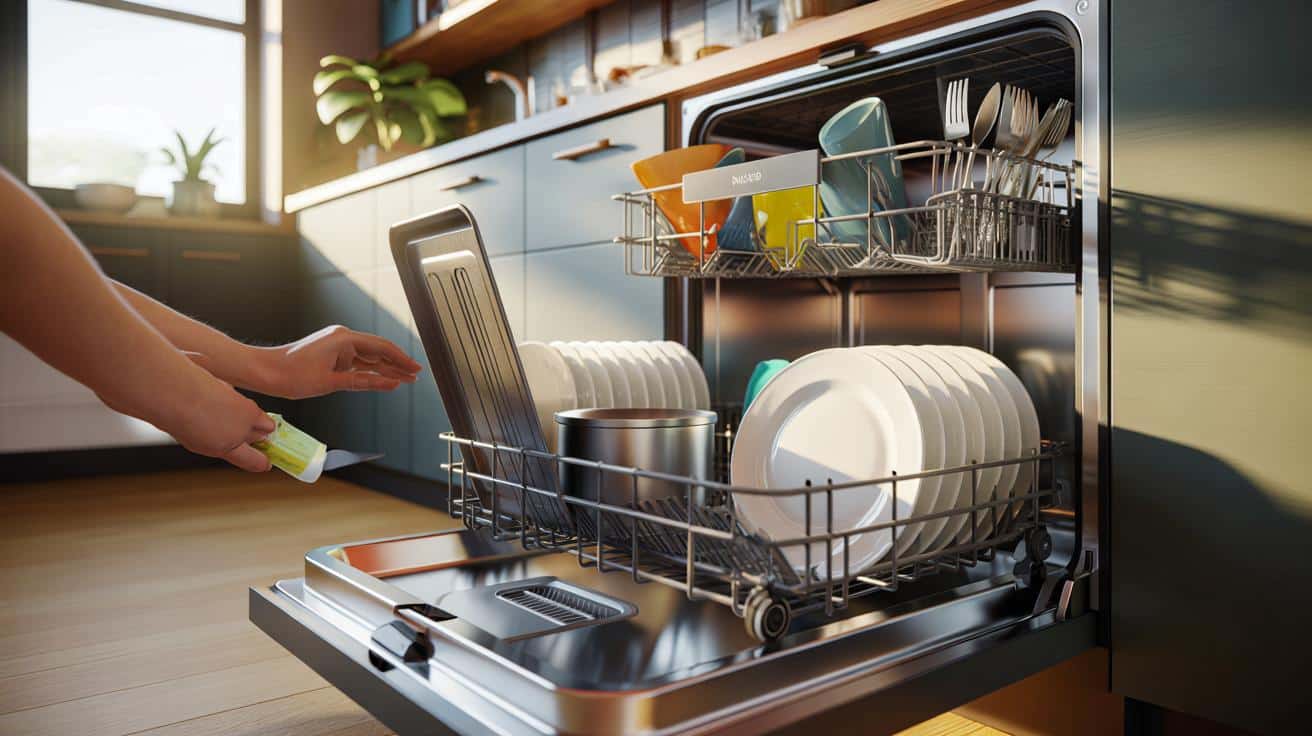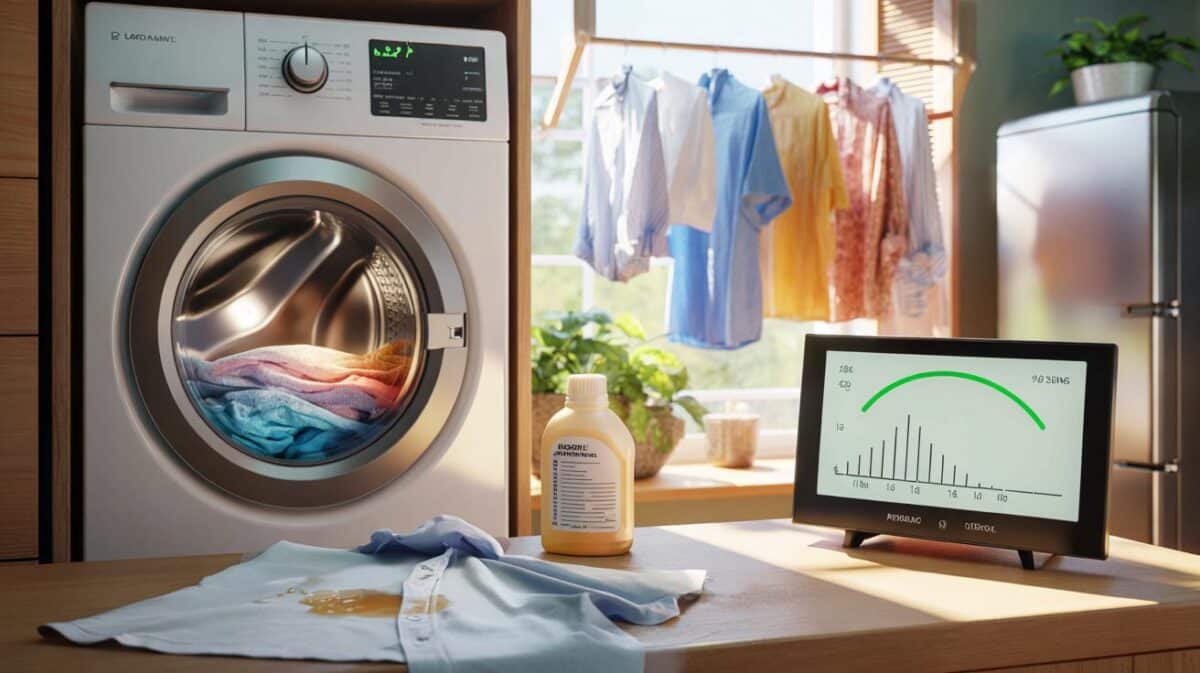A sloppy load forces longer cycles, repeat washes and energy-hungry drying. Stack like a pro and you cut both bills and faff, without living like a monk or scrubbing at midnight.
The other night, the kitchen was quiet but for the hum of the machine and the click of a cooling hob. I opened the door to a warm cloud and found one plate wearing a perfect halo of baked-on egg — like a smug badge of defeat. My neighbour, a catering manager, looked at my racks and laughed: “You made a wall.” She rotated a bowl, flipped a spoon, moved a chopping board to the side like a stagehand. I pressed start again. The wash that followed was shorter, calmer, and the egg halo vanished as if it had never happened. Sometimes the fix is smaller than the mistake. The trick wasn’t more soap or hotter water. It was the angles.
The simple mechanics most people ignore
Dishwashers don’t scrub; they throw hot, detergent-laced water in controlled bursts and let enzymes and time do the rest. Everything is about line of sight to the spray arms and keeping paths open. Put items where the jets can actually hit them and they’ll clean at lower temperatures, which trims both electricity and gas demand in the background.
We’ve all had that moment when you fish out a “clean” spoon and find it wearing yesterday’s yoghurt in the hollow. That’s shadowing — when one item hides another from the water. UK trials show modern eco cycles can sip roughly 9–12 litres per load and around 0.7–1.0 kWh, while a running tap can waste many times that just in the pre-rinse. My dad used to run the hot for a full minute before loading, convinced he was helping; he was only heating the pipework with gas.
Think of the rack as a wind tunnel for water. Gaps matter. Thermal mass matters too: heavy ceramics hold heat and drive faster drying if they’re not crammed. Rinse aid lowers surface tension so droplets slide off instead of clinging and demanding heat-dry. Keep the filter clean and the spray arms free of rice or lemon pips and you’ll keep pressure up — that’s free performance.
Load it like a pro: patterns that save watts
Start with a simple rule: plates on the bottom rack, lined up, facing the centre and slightly tilted so water can sheet off. Bowls on the top rack, angled, open to the spray — not nested. Pans go low and to the sides, never over the middle hub, and leave a finger’s width around the lower spray arm; **load by zones** and the machine’s brain does the rest.
Cutlery likes variety: mix spoons with forks to stop “spooning”, and point sharp blades down for safety. Plastics fear heat, so keep them top-rack and anchored so they don’t flip and pool water. Big flat things — chopping boards, trays, pizza stones — belong at the edges, never across the front where they block detergent and heat. Let’s be honest: nobody actually does that every single day. Aim for “mostly right” and you’ll still win on energy.
Run tabs or powder in the dispenser only, not tossed in the tub, so they release at the right time. Salt and rinse aid still matter in hard-water areas, even with “3‑in‑1” pods; check your hardness setting with a strip and set it once.
“Ninety per cent of cleaning performance is decided at the rack,” said a veteran appliance engineer we spoke to. “Sensors and cycles are clever, but angles and gaps make the magic cheap.”
- Let plates face the spray — not each other.
- Keep 5 cm clearance around the lower arm; spin it by hand before starting.
- Put the dirtiest face inward and downward; give jets a target.
- Pods for hot, powder for flexibility on eco cycles.
- Air‑dry beats heat‑dry — crack the door at the end to save juice.
Smarter cycles, lower bills
Eco isn’t code for “weak”. It’s longer, cooler water with more soaking time, and modern enzymes were built for it. Use it for 80% of loads and you’ll cut electricity, while the gas boiler sits idle because the dishwasher heats its own water efficiently. Save Intensive for greasy roasters or when you’ve left plates all day and the curry has turned to lacquer.
Don’t pre‑rinse under a hot tap; just scrape. Pre‑rinsing steals heat from your boiler and confuses soil sensors into thinking everything is already clean, which can shorten the wash at the worst time. If you’re worried about odours, run a short prewash or a “rinse and hold” with cold water. Small household? Use half‑load only when your machine truly supports it on the selected rack; otherwise you’ll pay close to full energy for less work.
Timing can shave pennies. If you’ve got a time‑of‑use tariff, run overnight or in the early afternoon if you’ve got solar. Skip heated dry and pop the door at the end for a minute — the hot, humid air whooshes out and plastics won’t stay sweaty. A monthly maintenance run with a cleaner or a mug of citric acid on hot keeps limescale down so heat transfer stays snappy and sensors read right.
This isn’t about being perfect; it’s about being a bit intentional. When you treat the racks like lanes for water and light, the whole kitchen slows down in a good way. You start saving energy without juggling settings every night, and dinner plates come out calm, warm and done. You might even notice the hum of the cycle as a kind of house music, not a countdown to rewashing.
| Key points | Detail | Reader Interest |
|---|---|---|
| Load by zones | Plates face centre, bowls angled top‑rack, pans at the sides, leave spray‑arm clearance | Immediate, visual win; fewer rewashes |
| Use eco for most loads | Longer time, lower heat; enzymes do the work and trim kWh | Lower bills without extra effort |
| Dry smart | Skip heat‑dry and crack the door; plastics stay drier with less energy | Quick habit change, visible results |
FAQ :
- Can I connect my dishwasher to a hot water supply?Some models allow hot fill up to a set temperature, many are cold‑fill only; check your manual, as hot feed can upset sensors or waste heat on long pipe runs.
- Is the eco cycle actually worth it?Yes — it trades time for lower heat, often cutting electricity use by a third or more while cleaning just as well on normal soil.
- Should I pre‑rinse dishes?No — scrape solids, that’s it; pre‑rinsing wastes water and can trick soil sensors into shorter, weaker washes.
- When’s the cheapest time to run?On time‑of‑use tariffs, overnight or off‑peak windows; with solar, midday; use delay start and keep doors closed for safety if you’re asleep.
- How often should I clean filters and spray arms?Filter weekly if you cook daily, monthly otherwise; pull spray arms each quarter to flush out seeds and scale for full pressure.








